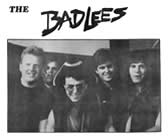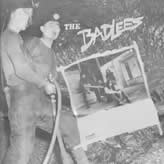Badlees Biography
2
The album, What Goes Around, was made up of seven tracks of four original songs (three duplicate re-mix versions). All but one
was co-written by Jeff Feltenberger and Bill Grabowski, and the sound produced was definitive eighties and the song structure
pretty standard for the time, with just a bit of edge.
As engineer, Bret Alexander put in long hours working on the album, and lent his talents to recording several overdubs.
Ultimately, he was asked to join as the fifth permanent member of Bad Lee White.
What Goes Around by Bad Lee White was released in October 1988. It received good press and reviews in national
publications such as Billboard Magazine and Cashbox. However, some personnel shifts at A-Street soon ended its short run as an
independent label kept the album from reaching a second pressing, and it soon fell off the radar.
Bad Lee White entered a period of adjustment and realignment. Guitarist Clint Barrick left the group and was later
followed by bassist Steve Feltenberger, who enlisted in the Marines. Susquehanna Sound became a hub for the remaining members.
Bret continued as chief engineer and Jeff and Ron frequently joined him to work on sessions or rehearse new material.
 One day, a local band named Anthem from nearby Susquehanna University came in to record at the studio. Anthem had a
dynamic 21-year-old singer named Pete Palladino. The guys hit it off with Pete and once Anthem’s sessions were complete, Jeff,
Bret, and Scott Berger would often meet up with Pete on "10-cent wing" nights at local bars and talk about their various musical
projects and plans. On one such night, Jeff approached Pete with an offer to join Bad Lee White as their front man, which he
accepted. Soon after, the newly revised band officially changed their name to what fans had begun commonly calling them at shows,
The Badlees.
One day, a local band named Anthem from nearby Susquehanna University came in to record at the studio. Anthem had a
dynamic 21-year-old singer named Pete Palladino. The guys hit it off with Pete and once Anthem’s sessions were complete, Jeff,
Bret, and Scott Berger would often meet up with Pete on "10-cent wing" nights at local bars and talk about their various musical
projects and plans. On one such night, Jeff approached Pete with an offer to join Bad Lee White as their front man, which he
accepted. Soon after, the newly revised band officially changed their name to what fans had begun commonly calling them at shows,
The Badlees.
While reading his copy of The Hazleton Standard Speaker one morning, Hazleton, PA disc jockey Mike Naydock noticed an
article about a native of nearby McAdoo who had just finished a professional album with a band called Bad Lee White. Naydock, who
had written several songs, was intrigued and contacted Terry Selders who was impressed with his songwriting. He introduced Mike to
Jeff Feltenberger to begin work on new songs.
However, another shift as the band morphed from Bad Lee White to The Badlees was the emergence of Bret Alexander as chief
songwriter and music director. Bret began to take the reins in forging the new Badlees sound, scheduling rehearsals, setting
performance agendas, and eventually producing and/or engineering all of their albums.
 Bret found an ideal songwriting counterpart when Mike Naydock entered the scene. Starting with the first Badlees EP, It Ain’t For You
in 1990, the role of Alexander as the prime mover behind the band's sound would persist throughout the band's career and the songwriting partnership
of Alexander/Naydock would produce some of their most famous songs.
Bret found an ideal songwriting counterpart when Mike Naydock entered the scene. Starting with the first Badlees EP, It Ain’t For You
in 1990, the role of Alexander as the prime mover behind the band's sound would persist throughout the band's career and the songwriting partnership
of Alexander/Naydock would produce some of their most famous songs.
While Bret's areas of expertise were fast becoming the studio and rehearsal room, the domain of new singer Pete Palladino
would definitely be the stage, jumping on tables and swinging from chandeliers to entertain the crowds, and soon the crowd sizes
swelled.
These crowd sizes were instrumental to the early success of the Badlees since they were dedicated to performing mostly
original material, which was not at all typical in rural Pennsylvania in the early nineties when cover bands playing Top 40 hits
were the only consistent money makers. Many clubs would not even entertain the idea of booking an original band, but the Badlees
ever growing crowds, they were granted an exception to many of these policies and it wasn’t long before they were regularly
playing their unique act out four or five nights per week.
On October 10, 1990, the Badlees released It Ain’t For You. Terry Selders, working now at Bassment Records back in
New York, acted as the defacto manager of the band from afar and put out It Ain't For You on his newly-formed independent label,
Rite-Off Records.
Just like the Bad Lee White EP, there was positive press, mainly in local media, but also with national publications like
Billboard magazine, which gave it the famed "Critics' Choice" award.
With this success, the Badlees landed a gig opening for the band Firehouse at the Metron in Harrisburg, PA, at the time
when Firehouse was at their absolute peak nationally with a #1 song on the charts.
Terry Selders soon returned to central Pennsylvania to be manager of the Badlees full time and set up the band’s
headquarters in Selinsgrove. The band then turned their focus on writing and recording their first full-length album.
Paul Smith was a guitarist originally from Camp Hill, PA, who had interned at Susquehanna Sound and soon became friends
with members of the Badlees. Everyone liked and respected Paul and they asked him to join the band as the permanent bass player.
Since the departure of Steve Feltenberger, the band had used an interim bass player named Ric Stehman. Now, with the addition of
Smith on bass, the Badlees quintet that would drive through their most productive years was now in place.
 In early 1992, the band released Diamonds In the Coal. Thematically, the album was nearly sliced in half by the with
mainly pop-oriented songs with strong hooks early songs with richer musical structure that explore deeper subject matter later on.
The album features the closing song of the same name, which brings the listener into the dark, forgotten patch towns of
Pennsylvania's anthracite region. For the cover and within the packaging, the band chose authentic early 20th century miner
photos, from the Tamaqua (PA) Historical Society.
In early 1992, the band released Diamonds In the Coal. Thematically, the album was nearly sliced in half by the with
mainly pop-oriented songs with strong hooks early songs with richer musical structure that explore deeper subject matter later on.
The album features the closing song of the same name, which brings the listener into the dark, forgotten patch towns of
Pennsylvania's anthracite region. For the cover and within the packaging, the band chose authentic early 20th century miner
photos, from the Tamaqua (PA) Historical Society.
The band soon landed a corporate sponsorship with Budweiser, who liked the fact that they played out virtually non-stop.
To keep these prolific shows filled, they worked hard to grow and maintain their fan base through a custom mailing list and by
setting up a "Badlees hotline" where fans could get the latest information. The band also occasionally booked some New York City
gigs at famous night clubs such as The China Club and CBGB’s, for which they would provide bus trips for their loyal Pennsylvania
fans.
By 1993, as the Badlees prepared to work on their second full-length album, they decided to take quite a different
approach by enlisting Jack Pyers, formally of the metal band Dirty Looks, as producer. The resulting effort was called The
Unfortunate Result of Spare Time, which portrayed a more “live” sound for the band, in the hopes of capturing some of the energy
of their live shows. However, the album deviated from the “roots rock” approach that was established on Diamonds In the Coal.
Badlees Biography
|
|---|
| 1 | 2 |
3 | 4 |
5 |
 One day, a local band named Anthem from nearby Susquehanna University came in to record at the studio. Anthem had a
dynamic 21-year-old singer named Pete Palladino. The guys hit it off with Pete and once Anthem’s sessions were complete, Jeff,
Bret, and Scott Berger would often meet up with Pete on "10-cent wing" nights at local bars and talk about their various musical
projects and plans. On one such night, Jeff approached Pete with an offer to join Bad Lee White as their front man, which he
accepted. Soon after, the newly revised band officially changed their name to what fans had begun commonly calling them at shows,
The Badlees.
One day, a local band named Anthem from nearby Susquehanna University came in to record at the studio. Anthem had a
dynamic 21-year-old singer named Pete Palladino. The guys hit it off with Pete and once Anthem’s sessions were complete, Jeff,
Bret, and Scott Berger would often meet up with Pete on "10-cent wing" nights at local bars and talk about their various musical
projects and plans. On one such night, Jeff approached Pete with an offer to join Bad Lee White as their front man, which he
accepted. Soon after, the newly revised band officially changed their name to what fans had begun commonly calling them at shows,
The Badlees.
 Bret found an ideal songwriting counterpart when Mike Naydock entered the scene. Starting with the first Badlees EP, It Ain’t For You
in 1990, the role of Alexander as the prime mover behind the band's sound would persist throughout the band's career and the songwriting partnership
of Alexander/Naydock would produce some of their most famous songs.
Bret found an ideal songwriting counterpart when Mike Naydock entered the scene. Starting with the first Badlees EP, It Ain’t For You
in 1990, the role of Alexander as the prime mover behind the band's sound would persist throughout the band's career and the songwriting partnership
of Alexander/Naydock would produce some of their most famous songs.
 In early 1992, the band released Diamonds In the Coal. Thematically, the album was nearly sliced in half by the with
mainly pop-oriented songs with strong hooks early songs with richer musical structure that explore deeper subject matter later on.
The album features the closing song of the same name, which brings the listener into the dark, forgotten patch towns of
Pennsylvania's anthracite region. For the cover and within the packaging, the band chose authentic early 20th century miner
photos, from the Tamaqua (PA) Historical Society.
In early 1992, the band released Diamonds In the Coal. Thematically, the album was nearly sliced in half by the with
mainly pop-oriented songs with strong hooks early songs with richer musical structure that explore deeper subject matter later on.
The album features the closing song of the same name, which brings the listener into the dark, forgotten patch towns of
Pennsylvania's anthracite region. For the cover and within the packaging, the band chose authentic early 20th century miner
photos, from the Tamaqua (PA) Historical Society.









